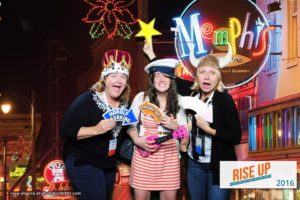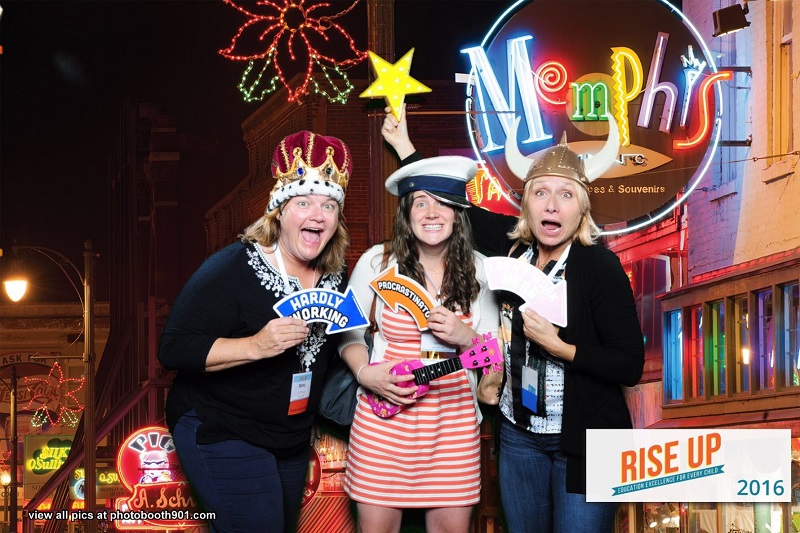The 7th Annual StriveTogether Cradle to Career Network Convening took place in Memphis, Tennessee, from September 20-22. There were nearly 400 educators, elected officials, community leaders, business executives, nonprofit professionals, and policymakers gathered there.
 Eastside Pathways, one of 68 partnerships from 32 states, was well represented by Kelly Jones, data officer, and two collaborative facilitators, Betsy Johnson (Summer and Extended Learning) and Monika Steen (Career Pathways). The theme this year was Rise Up: Education Excellence for Every Child, with the focus on identifying practices to eliminate disparities for every child in every community across the country.
Eastside Pathways, one of 68 partnerships from 32 states, was well represented by Kelly Jones, data officer, and two collaborative facilitators, Betsy Johnson (Summer and Extended Learning) and Monika Steen (Career Pathways). The theme this year was Rise Up: Education Excellence for Every Child, with the focus on identifying practices to eliminate disparities for every child in every community across the country.
For the third year, StriveTogether used the closing morning of the convening to present the Bill Henningsgaard Cradle to Career Champion Award in honor of Bill’s enduring legacy. This year’s deserving recipients were Scott and Anne Jones from Every Hand Joined in Red Wing, Minnesota. Our heartfelt congratulations go out to Scott and Anne for their tremendous work.
Jeff Edmondson, managing director of StriveTogether, deemed the convening a success and shared his takeaways on his blog. Betsy, Monika, and Kelly brought back experiences and insights of their own from the conference.
Betsy Johnson
It was interesting to see the communities facing similar challenges to those in Bellevue from school readiness to early learning quality to 3rd grade reading to college and career readiness and their approaches. It is tempting to want to use other communities’ bright spots and apply them to Bellevue. Collective impact, however, is about using data wisely to focus and continuously improve. One of my favorite quotes from the convening was from our Tacoma neighbors, “let the data do the work” in convincing people for the need for policy and program shifts that will benefit kids.
One of the most powerful presentations I attended in Memphis was on using data more strategically. A data outcomes pathway was laid out that helped me think about how we could collect relevant data, use the data we have better and work around the data we do not yet have. The conference also gave me a renewed sense of urgency, as one of the plenary speakers, Becky Margiotta, co-founder, and president of the Billions Institute said, “Have a clear-cut aim. Some is not a number and soon is not a time.”
Monika Steen
One general observation about the Network overall: we have successfully made the shift from partners simply talking about working together to partners actually changing how they work every day to improve outcomes. We are no longer talking about getting to action. We are using data to act differently and seeing real and tangible improvements as results.
The Convening was jam-packed with powerful keynotes and interactive workshops focused on confronting the inherent inequities in education, growing local momentum to change systems, and sharing best practices for data-driven collective impact work from partnerships across the country.
Key takeaways:
Find Equity Impact Agents: Let’s find a lift up people changing their behavior to specifically eliminate achievement gaps—partners who have used data with children, families, and practitioners to identify and spread what works for the most vulnerable student. Let’s make them rock stars we can all work to emulate.
Take on Structural Racism: We need to navigate challenging discussions around race, class, and culture in our community to address the root of structural racism that often prevents us from spreading what works and meeting the real needs of our most vulnerable students. We need to make sure everyone can get in the HOV lane on the education highway!
Use Data in a Smart Way: We must engage parents and caregivers, students and educators to help us better understand what the data tells us about both the real issues we must address and the real impact for the programs and services we are analyzing.
Kelly Jones
As Betsy and Monika highlighted, effective use of data was a key theme of the convening, especially with an eye to equity and action. The three of us used our “team time” to apply this learning to our Eastside Pathways goals, indicators, work chart, and collaboratives. We brainstormed how to embed data more consistently and strategically in the collaboratives and identified opportunities for greater clarity in our work chart. Those discussions will continue throughout the fall with partner involvement.
The best session I attended was hosted by our neighbor to the east, Excelerate Success in Spokane, about network science. This discipline provides a way to measure changes in the strength, connectedness, and trust within a network. Network science could be a key tool in evaluating the partnership’s progress.

